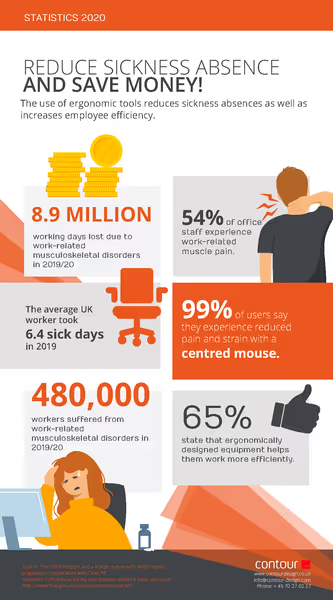Sick leave and ergonomics are heavily interlinked. Neither body nor mind is designed to make small, repetitive movements for hours in front of a screen. Therefore, poor ergonomics is top of the list of the most common causes for sick leave.
More than half of office workers experience muscle pain, and sedentary office workers account for 38% of all sick leave.
Read more: This is why an ergonomic mouse is worth the investment
This means that if you are feeling pain from your office work, you are not alone. Poor ergonomics in the workplace and sick leave result in invisible wear and tear on employees. Therefore, the employer must take it seriously.
Poor ergonomics are expensive
Sedentary work often drives the tension in the neck and shoulder area, while pain in the neck occurs more frequently for employees who perform office work than any other type of worker. Something that directly affects workability.
Not only does this affect the individual employee who reports in sick. It is also expensive – both for the workplace and society as a whole.

Include ergonomics in efforts to reduce sick leave
Although many workplaces have ergonomic solutions, sick leave can still be a problem as ergonomics is not a standard solution that suits all. Everyone is different and thus needs individual solutions. As such, an inflexible "off-the-rack" solution will not necessarily prevent sick leave.
Read more: 5 tips to reduce sick leave with ergonomics
Problems arise when health solutions do not take into account the full complexity of employees' health. When offices are set up, each department might do things differently – with little communication between departments. That can lead to less than optimal conditions for employees if no department puts health as a priority.
Facts about keyboard and mouse
- The keyboard must be tilting.
- There must be sufficient space in front of the keyboard and mouse for arms to rest on the table.
- Laptops must be equipped with a separate screen, keyboard and mouse when used more than 2 hours a day, or approximately a full working day weekly.
Source: The Sector Working Environment Committee for Retail, Finance and Offices
Reduce sick leave with good ergonomics
Sedentary work and repeated movements in front of the screen cause pain for 2/3 of office workers, according to a survey conducted by the Danish trade union for office workers in the public sector, HK STAT.
Therefore, it is essential that you make sure that your employees have the necessary tools and conditions to keep performing their work.
Read also: Everything you must know about taking sick leave in the UK.

Fortunately, there is a lot you can do – and especially when it comes to prevention. First of all, you can skip the standard solutions and instead focus on the individual employee's needs:
- When choosing a computer mouse, make sure that it fits the individual employee and their tasks.
- Choose a keyboard with a matte surface so that it reflects less light.
- Make sure to organize the work so that the employee gets time off the computer.
- Think about ergonomics as a larger whole.
- Listen to your employee's needs.







